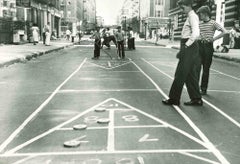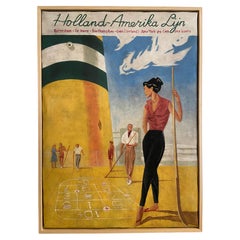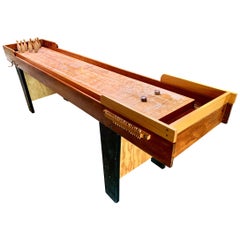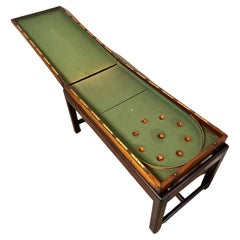Used Shuffleboards
Shuffleboard - American Vintage Photograph - Mid 20th Century
Located in Roma, IT
Shuffleboard - American Vintage Photograph is an original black and white photograph realized in
Category
Mid-20th Century Modern Used Shuffleboards
Materials
Photographic Paper
$123 Sale Price
35% Off
H 9.85 in W 7.88 in D 0.04 in
'Holland Amerika Lijn' painting
Located in 'S-HERTOGENBOSCH, NL
Painting, oil on canvas. Playing a shuffleboard game on deck, on a cruise ship of HAL (Holland
Category
1950s Dutch Mid-Century Modern Used Shuffleboards
Materials
Canvas
Recent Sales
Vintage Shuffleboard Bowling Table
Located in Los Angeles, CA
Cool vintage shuffleboard bowling table. Great lines and detail. Burgundy leather bumpers, wood
Category
1970s American Used Shuffleboards
Materials
Leather, Wood
Antique English Victorian Bagatelle Flip Top Game Table on Stand
Located in Forney, TX
versions, including French/Belgian game billard russe, English shovel-board or shuffleboard, French trou
Category
Late 19th Century Victorian Used Shuffleboards
Materials
Brass
Wooden Carrom Board Game
Located in Sheffield, MA
board, similar to billiards and shuffleboard. This particular board is done in muted colors of reds and
Category
1930s American Used Shuffleboards
Materials
Wood
Antique Brunswick Shuffleboard Game Table or Board
By Brunswick Co.
Located in Chicago, IL
Antique Brunswick Shuffleboard table. Great as a decorative wall piece.
Category
1930s American Used Shuffleboards
Materials
Wood
People Also Browsed
Set of 2 lacquered and painted doors, green and yellow, 18th century Rome
Located in Cuneo, Italy (CN)
Set of 2 antique doors, lacquered and hand painted with fomrelle with typical floral designs, predominantly green and yellow, hand-built in the 18th century for a palazzo in Italy, i...
Category
18th Century Italian Used Shuffleboards
Materials
Wood
$6,649 Sale Price / set
20% Off
H 87.8 in W 42.92 in D 1.97 in
English Cricket Clover Side Table
Located in Westwood, NJ
A mahogany and reclaimed oak 'Clover' table, the trefoil top above a triangular frieze and Cricket base, on three turned and block legs joined by board stretchers.
Dimensions: 24.5"...
Category
21st Century and Contemporary Vietnamese Country Used Shuffleboards
Materials
Wood
Hand-Painted Decorative Iron Tray - Giraffe
By Bertrando Di Renzo
Located in ROCCAVIVARA CB, IT
Bring vibrant charm to your decor with our hand-painted iron tray, featuring a giraffe design on a teal blue background. Perfect for adding a playful yet sophisticated touch to coffe...
Category
21st Century and Contemporary Indian Modern Used Shuffleboards
Materials
Iron
H-269 Halabala Armchair By Jindřich Halabala For Up Závody, Czechoslovakia, 1920
By Up Závody, Jindřich Halabala
Located in Zohor, SK
Iconic armchair designed by Jindrich Halabala for UP Zavody, Czechoslovakia in 1920s. The chair is H-269 model. This model has a very dynamic and abundant appearance. Beautifully cur...
Category
1920s Czech Art Deco Used Shuffleboards
Materials
Velvet, Oak
$2,582 Sale Price
50% Off
H 27.96 in W 24.41 in D 34.65 in
A bay horse in a wooded landscape
Located in Stoke, Hampshire
John Nost Sartorius (London 1759-1828)
A bay horse in a wooded landscape
Signed 'J.N.Sartorius' lower right
Oil on canvas
Canvas Size - 12 x 14 in
Framed Size - 19 x 21 in
John Nost...
Category
18th Century Old Masters Used Shuffleboards
Materials
Oil
Art Deco Red Bakelite Box of Cylindrical Form, Black Bakelite Ball Feet and Knob
Located in Chapel Hill, NC
Art Deco cherry red Bakelite desk or vanity box of cylindrical form with a stepped molded base and conforming lid with a black Bakelite ball knob and raised on three black Bakelite b...
Category
Early 20th Century French Art Deco Used Shuffleboards
Materials
Bakelite
$225
H 3.5 in Dm 3.5 in
Tibetan Trailing Vines Cabinet, c. 1900
Located in Chicago, IL
Crafted in late 19th-century Tibet, this charming side cabinet is beautifully decorated in the Sino-Tibetan style with an allover design of trailing vines and geometric scrollwork. A...
Category
Late 19th Century Tibetan Tibetan Used Shuffleboards
Materials
Pine
19th century, Grey Horse in a Stable, oil, Albert Clark
By Albert Clark
Located in York, GB
A 19th century oil painting on canvas of a Grey Horse in a Stable.
Signed and dated 1890, housed in a gilt frame.
The size of the painting being 17" x 21" (43.2 x 53.3cm) whilst...
Category
19th Century Old Masters Used Shuffleboards
Materials
Oil
$4,723
H 22.05 in W 26.38 in
18th Century French Oak Country Vaisselier Buffet Hutch Sideboard w Clock 102"
Located in Dayton, OH
#41402
Antique late 18th century Country French buffet / hutch / vaisselier with Horloge (clock). Made of oak featuring French country / provincial styling with carved flowers / fl...
Category
Late 18th Century French Provincial Used Shuffleboards
Materials
Oak
$5,950 Sale Price
30% Off
H 101.75 in W 97 in D 25.5 in
Huge 1830's British Oil Painting on Canvas Farmyard Scene with Animals Landscape
Located in Cirencester, Gloucestershire
The Victorian Farmyard
British School, circa 1830
oil on canvas, unframed
canvas: 34 x 48 inches
provenance: private collection, England
condition: good and sound condition, though w...
Category
Early 19th Century Victorian Used Shuffleboards
Materials
Oil, Canvas
$1,887 Sale Price
30% Off
H 34 in W 48 in
Antique 17th-century chest/safe covered in leather with the original key
Located in Harderwijk, NL
This beautiful and original 17th-century Spanish chest is covered in leather and is a truly unique eye-catcher. It’s an extraordinary item for true antique enthusiasts who appreciat...
Category
17th Century Spanish Used Shuffleboards
Materials
Leather
$1,870
H 17.72 in W 27.76 in D 14.18 in
Superb Old Wooden Hut Door from Africa
Located in Antwerp, BE
Old wooden hut door from Cameroon, decorated with carved crocodile, bird, snake and a knife within geometric ornament in the traditional ethnic style.
Superb old door African sculpt...
Category
20th Century Cameroonian Tribal Used Shuffleboards
Materials
Iron
Eggshell Lacquered Box & Cover In The Form of A House by Artist Thierry Voeltzel
Located in Lowestoft, GB
A rather wonderful box and cover in the form of a Georgian home, wooden carcass with a lacquered finish over a mosaic of eggshells.
The stepped cover/roof lifts to reveal a internal...
Category
21st Century and Contemporary French Used Shuffleboards
Materials
Eggshell, Pine, Lacquer
$3,367
H 35.63 in W 15.75 in D 15.75 in
French Modern Neoclassical Chinese Red Lacquer Sideboard by Jacques Adnet
By Jacques Adnet
Located in New York, NY
Two Rare and Exceptional French Mid-Century Modern Neoclassical Sideboards in Chinese red lacquer with Chinese red glass tops by Jacques Adnet, France, 1940-1950. (The 2 pieces are p...
Category
Mid-20th Century French Mid-Century Modern Used Shuffleboards
Materials
Wrought Iron
$28,875 / item
H 36 in W 46.25 in D 15.75 in
Swedish Bench with Neoclassical Carving
Located in New Orleans, LA
The relatively narrow seat on this Gustavian bench makes it perfect for a hallway or as secondary seating in a living room. Simple lines with straight sides and back are decorated w...
Category
19th Century Swedish Used Shuffleboards
Materials
Fabric, Wood
Vintage Verdigris Bronze Boy & Girl Water Fountain Sculpture Signed Vernon Geyco
Located in Dallas, TX
This elegant outdoor fountain was crafted in America, circa 1980. Made of bronze and built in two pieces, the fountain features a boy lifting a shell to pour water on the girl below....
Category
Late 20th Century American Used Shuffleboards
Materials
Bronze
$3,900
H 41 in W 26 in D 25 in
Get Updated with New Arrivals
Save "Used Shuffleboards", and we’ll notify you when there are new listings in this category.
More Ways To Browse
Godhelp De Raad
Dutch Ship
Used Bowling Furniture
American Revolutionary War
Board Game Tables
Bowling Pins
Italian Louis Xvi Dining Chairs
Mahogany Flip Top Bar
Used Board Game Table
Antique Croquet
Foldable High Top Chairs And Table
Louis Xvi King Bed Frame
18th Century New England Dining Table
Dining Table With Ivory Inlay
Used Bowling Woods
Pinball Game
Pinball Machine
Victorian Flip Table



